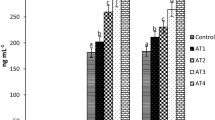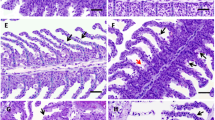Abstract
Diflubenzuron (DFB) is a widely used insecticide to control ectoparasites in fish farming. Although therapeutic concentrations (i.e., 50 to 100 mg/L) are safe as they fail to induce mortality, they can promote tissue changes. In Brazil, Pacu (Piaractus mesopotamicus) is a native species used for commercial production, and it remains crucial to determine underlying mechanisms to mitigate the potential effects of pathogens on productivity. The aim of this study was to analyze the transaminase profile and histopathological changes in the liver of P. mesopotamicus exposed to a DFB bath. Hence, the fish were exposed to an immersion bath containing a 70 mg/L nominal concentration of Difluchem 240 SC® (24% (m/m) DFB) for 30 (n = 10), 60 (n = 10), and 120 min (n = 10), every 24 h for 3 days. Following exposure, plasma transaminases and liver histology were analyzed. In DFB-exposed fish, levels of aspartate transaminase (AST) and alanine transaminase (ALT) were elevated when compared with the control at 30 and 60 min. Furthermore, liver morphology was altered based on exposure times. Compared with controls, the degree of reversible damage (degree of tissue change (DTC)) demonstrated high scores for all exposure times, with no difference between individual groups. Irreversible changes were increased in the 60 and 120-min baths. These findings highlight the impact of the therapeutic DFB concentration (i.e., 70 mg/L), revealing that 60-min and 120-min bathing induces irreversible and progressive hepatic changes.



Similar content being viewed by others
Data availability
The datasets used and/or analyzed during the current study are available from the corresponding author on reasonable request.
References
Ardeshir RA, Zolgharnein H, Movahedinia A, Salamat N, Zabihi E (2017) Comparison of waterborne and intraperitoneal exposure to fipronil in the Caspian white fish (Rutilus frisii) on acute toxicity and histopathology. Toxicol Rep 4:348–357. https://doi.org/10.1016/j.toxrep.2017.06.010
Benze TP, Sakuragui MM, De Paula Zago LH, Fernandes MN (2016) Subchronic exposure to diflubenzuron causes health disorders in neotropical freshwater fish, Prochilodus lineatus. Environ Toxicol 31:533–542. https://doi.org/10.1002/tox.22065
Bernet D, Schmidt H, Meier W, Burkhardt-Holm P, Wahli T (1999) Histopathology in fish: proposal for a protocol to assess aquatic pollution. J Fish Dis 22:25–34. https://doi.org/10.1046/j.1365-2761.1999.00134.x
Branson EJ, Rønsberg SS, Ritchie G (2000) Efficacy of teflubenzuron (Calicide®) for the treatment of sea lice, lepeophtheirus salmonis (Krøyer 1838), infestations of farmed Atlantic salmon (Salmo salar L.). Aquac Res 31:861–867. https://doi.org/10.1046/j.1365-2109.2000.00509.x
Brunk UT, Terman A (2002) Lipofuscin: mechanisms of age-related accumulation and influence on cell function. Free Radical Bio Med 33:611–619. https://doi.org/10.1016/S0891-5849(02)00959-0
Camargo MM, Martinez CB (2007) Histopathology of gills, kidney and liver of a Neotropical fish caged in an urban stream. Neotrop Ichthyol 5:327–336. https://doi.org/10.1590/S1679-62252007000300013
Campbell PJ, Hammell KL, Dohoo IR, Ritchie G (2006a) Randomized clinical trial to investigate the effectiveness of teflubenzuron for treating sea lice on Atlantic salmon. Dis Aquat Org 70:101–108. https://doi.org/10.3354/dao070101
Campbell PJ, Hammell KL, Dohoo IR, Ritchie G (2006b) Historical control clinical trial to assess the effectiveness of teflubenzuron for treating sea lice on Atlantic salmon. Dis Aquat Org 70:109–114. https://doi.org/10.3354/dao070109
Carson FL, Hlakik C (2009) Histotechnology. A self-instructional text. 3nd ed, ASCP Press, Hong Kong.
Cheville NF (2009) Ultrastructural pathology: the comparative cellular basis of disease. 2nd ed. Wiley-Blackwell A john Wiley of Sons, Inc. USA.
Cunha MA (2017) Legislação de Fármacos utilizados na Aquicultura. In: Gomes LC, Heinzmann BM, Cunha MA (eds) Baldisserotto B. Farmacologia aplicada a aquicultura, Santa Maria, pp 19–20
Dabrowski K, Guderley H (2002) Intermediary metabolism. In: Halver JE, Hardy RW (eds) Fish nutrition. 3.ed. Washington, D.C., Academic Press, pp 309-365
Dane H, Sisman T (2015) Histopathological changes in gill and liver of Capoeta capoeta living in the Karasu River, Erzurum. Environ Toxicol 30:904–917. https://doi.org/10.1002/tox.21965
Dantzger DD, Jonsson CM, Aoyama H (2018) Mixtures of diflubenzuron and p-chloroaniline changes the activities of enzymes biomarkers on tilapia fish (Oreochromis niloticus) in the presence and absence of soil. Ecotoxicol Environ Saf 148:367–376. https://doi.org/10.1016/j.ecoenv.2017.10.054
FAO (2018). World Food And Agriculture – Statistical Pocketbook 2018. Rome. 254 pp. Licence: CC BY-NC-SA 3.0 IGO
Fischer SA, Hall LW (1992) Environmental concentrations and aquatic toxicity data on diflubenzuron (Dimilin®). Crit Rev Toxicol 22:45–79. https://doi.org/10.3109/10408449209145321
Fossi MC, Leonzio C (1993) Nondestructive biomarkers in vertebrates. CRC Press
Grune T, Jung T, Merker K, Davies KJ (2004) Decreased proteolysis caused by protein aggregates, inclusion bodies, plaques, lipofuscin, ceroid, and ‘aggresomes’ during oxidative stress, aging, and disease. Int J Biochem Cell Biol 36:2519–2530. https://doi.org/10.1016/j.biocel.2004.04.020
Heath AG (1995) Liver. In. Heath AG (ed) Water pollution and fish physiology. Second Edition. Lewis Publishers, USA, pp.125-139
Hinton DE, Segner H, Braunbeck T (2001) Toxic responses of the liver. In: Schlenk D, Benson WH (eds),Target organ toxicity in marine and freshwater teleosts. Volume 1: Organs, Taylor & Francis, Fl. USA, pp. 248-298
Hohn A, Jung T, Grimm S, Catalgol B, Weber D, Grune T (2011) Lipofuscin inhibits the proteasome by binding to surface motifs. Free Radical Bio Med 50:585–591. https://doi.org/10.1016/j.freeradbiomed.2010.12.011
Huggett RJ, Kimerle RA, Mehrle PM Jr, Bergan HL (1992) Biomarkers: biochemical, physiological, and histological markers of anthropogenic stress. Lewis Publishers, Boca Raton, p 347
Jomori K, Carneiro DJ, Martins IEG, Portella MC (2005) Economic evaluation of Piaractus mesopotamicus juvenile production in different rearing systems. Aquaculture 243:175–183. https://doi.org/10.1016/j.aquaculture.2004.09.034
Kildea MA, Allan GL, Kearney RE (2004) Accumulation and clearance of the anesthetics clove oil and AQUI-STM from the edible tissue of silver perch (Bidyanus bidyanus). Aquaculture 232:265–277. https://doi.org/10.1016/S0044-8486(03)00483-6
Kleiner DE (2018) Drugs and toxins. In: MacSween’s Pathology of the Liver. Ed 7, Elsevier, pp.673-779.
Luvizotto-Santos R, Cordeiro PJM, Vieira EM (2009) Analysis of Diflubenzuron in tilapia filet by HPLC-DAD. J Chromatogr Sci 47:785–788. https://doi.org/10.1093/chromsci/47.9.785
Maduenho LP, Martinez CB (2008) Acute effects of diflubenzuron on the freshwater fish Prochilodus lineatus. Comp Biochem Physiol C148:265–272. https://doi.org/10.1016/j.cbpc.2008.06.010
Marcon L, Bazzoli N, Honor Mounteer A, Anjos Benjamin LD (2015) Histological and histometric evaluation of the liver in Astyanax bimaculatus (Teleostei: Characidae), exposed to different concentrations of an organochlorine insecticide. Anat Rec 298:1754–1764. https://doi.org/10.1002/ar.23196
Merzendorfer H, Kim HS, Chaudhari SS, Kumari M et al (2012) Genomic and proteomic studies on the effects of the insect growth regulator diflubenzuron in the model beetle species Tribolium castaneum. Insect Biochem Mol Biol 42:264–276. https://doi.org/10.1016/j.ibmb.2011.12.008
Metón I, Mediavilla D, Caseras A, Canto E, Fernández F, Baanante IV (1999) Effect of diet composition and ration size on key enzyme activities of glycolysis–gluconeogenesis, the pentose phosphate pathway and amino acid metabolism in liver of gilthead sea bream (Sparusaurata). Brit J Nutr 82:223–232. https://doi.org/10.1017/S0007114599001403
Moss DW, Henderson AR, Kochmar JF (1986) Enzymes; principles of diagnostic enzymology and the aminotransferases. In: Tietz NW (ed) Textbook of Clinical Chemistry. Saunders, Philadelphia pp, pp 663–678
Mourad NMN, Costa AC, Freitas RTF, Serafini MA, Reis Neto RV, Felizardo VO (2018) Weight and morphometric growth of Pacu (Piaractus mesopotamicus), Tambaqui (Colossoma macropumum) and their hybrids from spring to winter. Pesqui Vet Bras 38:544–550. https://doi.org/10.1590/1678-5150-pvb-4808
Olsvik PA, Samuelsen OB, Erdal A, Holmelid B, Lunestad BT (2013) Toxicological assessment of the anti-salmon lice drug diflubenzuron on Atlantic cod Gadus morhua. Dis Aquat Org 105:27–43. https://doi.org/10.3354/dao02613
Orchard GE (2013) Pigments and minerals. In. Survarna SK, Layton C, Bancroft JD (eds) Bancroft´s theory and practice of histological techiques. 8th ed, Elsevier, pp.198-230
Pelli A, Paula DR, Arruda AAM, Lopes JM, Ramos SM, Rezende APS (2008) Toxicidade aguda e crônica de diflubenzuron para o jáu, Zungaro zungaro (Humboldt, 1821) (Pisces, Pimelodidae). Revista Brasileira de Zoociências 10:51–54
Petitjean Q, Jean S, Gandar A, Côte J, Laffaille P, Jacquin L (2019) Stress responses in fish: from molecular to evolutionary processes. Sci Total Environ 684:371–380. https://doi.org/10.1016/j.scitotenv.2019.05.357
Rath S, Friedlander LG, Reuss R (2015) Residue monograph prepared by the meeting of the Joint FAO/WHO Expert Committee on Food Additives (JECFA), 81st meeting 2015 - Diflubenzuron. pp. 1-32.
Ritchie G, Rønsberg SS, Hoff KA, Branson EJ (2002) Clinical efficacy of teflubenzuron (Calicide®) for the treatment of Lepeophtheirus salmonis infestations of farmed Atlantic salmon Salmo salar at low water temperatures. Dis Aquat Org 51:101–106. https://doi.org/10.3354/dao051101
Schlenk D, Calander M, Gallagher EP, Gorge S, James M, Kulman SW, Van Den Hurk P, Willet K (2008) Biotransformation in Fishe. In.: Di Giulio RT, Hinton DE (eds) The Toxicology of Fishes. CRC Press, USA, pp.154-234
Schulter EP, Vieira Filho JER (2017) Evolução da piscicultura no brasil: diagnóstico e desenvolvimento da cadeia produtiva de tilápia. Texto para discussão / Instituto de Pesquisa Econômica Aplicada – IPEA/Ministério do Planejamento, Desenvolvimento e Gestão, Brasília pp.35
Schwaiger J, Wanke R, Adam S, Pawert M, Honnen W, Triebskorn R (1997) The use of histopathological indicators to evaluated contaminant-related stress in fish. J Aquat Ecosyst Stress Recover 6:75–86. https://doi.org/10.1023/A:1008212000208
Shiogiri NS, Paulino MG, Carraschi SP, Baraldi FG, Cruz C, Fernandes MN (2012) Acute exposure of a glyphosate-based herbicide affects the gills and liver of the Neotropical fish, Piaractus mesopotamicus. Environ Toxicol Pharmacol 34:388–396. https://doi.org/10.1016/j.etap.2012.05.007
Silva JJ, Mendes J (2002) Effects of Diflubenzuron on immature stages of Haematobia irritans (L.) (Diptera: Muscidae) in Uberlândia, State of Minas Gerais, Brazil. Mem Inst Oswaldo Cruz 97:679–682. https://doi.org/10.1590/S0074-02762002000500017
Solaini G, Baracca A, Lenaz G, Sgarbi G (2010) Hypoxia and mitochondrial oxidative metabolism. Biochim Biophys Acta Bioenerg 1797:1171–1177. https://doi.org/10.1016/j.bbabio.2010.02.011
Strnad P, Stumptner C, Zatloukal K, Denk H (2008) Intermediate Wlament cytoskeleton of the liver in health and disease. Histochem Cell Biol 129:735–749. https://doi.org/10.1007/s00418-008-0431-x
Strnad P, Nuraldeen R, Guldiken N, Hartmann D, Mahajan V, Denk H, Haybaeck J (2013) Broad spectrum of hepatocyte inclusions in humans, animals, and experimental models. Compr Physiol 3:1393–1436. https://doi.org/10.1002/cphy.c120032
Tavares-Dias M, Martins ML (2017) An overall estimation of losses caused by diseases in the Brazilian fish farms. J Parasit Dis 41:913–918. https://doi.org/10.1007/s12639-017-0938-y
Ursus-Nikolaus R, Werner M (2004) Color Atlas of Pathology. Pathologic Principes, Associated Diseases. Sequeles. Thieme, Stuttgard, Germany, p 457
Vassiliou G (2016) Factors affecting risk assessment of pesticides in water bodies: a review. MOJ Toxicology 2:26–32
Walling MA, Janovitz EB (2018) Morphological manifestations of toxic cell injury. In.:Wallig MA, Bolon B, Haschek WM, Rousseaux CG (eds) Fundamentals of toxicologic pathology, Academic Press, pp.59-81
WHO (2008) Diflubenzuron in drinking water: use for vector control in drinking-water sources and containers. Background document for development of WHO guidelines for drinking-water quality. Available at www.who.int/water_sanitation_health/dwq/chemicals/phe_wsh_diflubenzuron_fact_sheet.pdf. Accessed 23 April 2020.
Wolf JC, Wolfe MJ (2005) A brief overview of nonneoplastic hepatic toxicity in fish. Toxicol Pathol 33:75–85. https://doi.org/10.1080/01926230590890187
Funding
This study was funded in part by the Coordenação de Aperfeiçoamento de Pessoal de Nível Superior, Brasil (CAPES)—Finance Code 001 and the Fundação Universidade Federal de Mato Grosso do Sul (UFMS/MEC), Brazil. Fundação de Apoio ao Desenvolvimento do Ensino, Ciência e Tecnologia de Mato Grosso do Sul (FUNDECT/CAPES no. 07/2015) for scholarship to ALNS.
Author information
Authors and Affiliations
Contributions
ALNS conceptualization, investigation, methodology. RAR conceptualization, investigation, methodology. MSS investigation, methodology. KNNF investigation, methodology. KVK investigation, methodology. LFB formal analysis, writing original draft, and review & editing. CEF conceptualization, methodology, formal analysis, resources, writing original draft, and review & editing. All authors read and approved the final manuscript.
Corresponding author
Ethics declarations
Competing interests
The authors declare that they have no competing interests.
Ethics approval
Animal handling followed the AVMA Guidelines for the Euthanasia of Animals: 2020 Edition and procedures are in accordance to CONCEA (34/2017).
Consent to participate
Not applicable
Consent for publish
Not applicable
Additional information
Responsible Editor: Ludek Blaha
Publisher’s note
Springer Nature remains neutral with regard to jurisdictional claims in published maps and institutional affiliations.
Rights and permissions
About this article
Cite this article
Silva, A.L.N., Rodrigues, R.A., Siqueira, M.S. et al. Transaminase profile and hepatic histopathological traits in Piaractus mesopotamicus exposed to insecticide Diflubenzuron. Environ Sci Pollut Res 28, 22002–22010 (2021). https://doi.org/10.1007/s11356-020-12013-2
Received:
Accepted:
Published:
Issue Date:
DOI: https://doi.org/10.1007/s11356-020-12013-2




